Thermaltake Toughpower iRGB Plus 1200W Platinum PSU Review
Why you can trust Tom's Hardware
Transient Response Tests
Advanced Transient Response Tests
For details on our transient response testing, please click here.
Ιn these tests, we monitor the TPI-1200F2FDP's response in several scenarios. First, a transient load (10A at +12V, 5A at 5V, 5A at 3.3V, and 0.5A at 5VSB) is applied for 200ms as the PSU works at 20 percent load. In the second scenario, it's hit by the same transient load while operating at 50 percent load.
In the next sets of tests, we increase the transient load on the major rails with a new configuration: 15A at +12V, 6A at 5V, 6A at 3.3V, and 0.5A at 5VSB. We also increase the load-changing repetition rate from 5 Hz (200ms) to 50 Hz (20ms). Again, this runs with the PSU operating at 20 and 50 percent load.
The last tests are even tougher. Although we keep the same loads, the load-changing repetition rate rises to 1 KHz (1ms).
In all of the tests, we use an oscilloscope to measure the voltage drops caused by the transient load. The voltages should remain within the ATX specification's regulation limits.
These tests are crucial because they simulate the transient loads a PSU is likely to handle (such as booting a RAID array or an instant 100 percent load of CPU/GPUs). We call these "Advanced Transient Response Tests," and they are designed to be very tough to master, especially for a PSU with a capacity of less than 500W.
Advanced Transient Response at 20 Percent – 200ms
| Voltage | Before | After | Change | Pass/Fail |
|---|---|---|---|---|
| 12V | 12.024V | 11.970V | 0.45% | Pass |
| 5V | 5.057V | 5.003V | 1.07% | Pass |
| 3.3V | 3.318V | 3.249V | 2.08% | Pass |
| 5VSB | 5.037V | 4.996V | 0.81% | Pass |
Advanced Transient Response at 20 Percent – 20ms
| Voltage | Before | After | Change | Pass/Fail |
|---|---|---|---|---|
| 12V | 12.023V | 11.947V | 0.63% | Pass |
| 5V | 5.057V | 4.994V | 1.25% | Pass |
| 3.3V | 3.318V | 3.241V | 2.32% | Pass |
| 5VSB | 5.037V | 4.993V | 0.87% | Pass |
Advanced Transient Response at 20 Percent – 1ms
| Voltage | Before | After | Change | Pass/Fail |
|---|---|---|---|---|
| 12V | 12.022V | 11.950V | 0.60% | Pass |
| 5V | 5.056V | 4.993V | 1.25% | Pass |
| 3.3V | 3.318V | 3.231V | 2.62% | Pass |
| 5VSB | 5.037V | 4.983V | 1.07% | Pass |
Advanced Transient Response at 50 Percent – 200ms
| Voltage | Before | After | Change | Pass/Fail |
|---|---|---|---|---|
| 12V | 12.015V | 11.960V | 0.46% | Pass |
| 5V | 5.048V | 5.000V | 0.95% | Pass |
| 3.3V | 3.310V | 3.239V | 2.15% | Pass |
| 5VSB | 5.020V | 4.975V | 0.90% | Pass |
Advanced Transient Response at 50 Percent – 20ms
| Voltage | Before | After | Change | Pass/Fail |
|---|---|---|---|---|
| 12V | 12.014V | 11.938V | 0.63% | Pass |
| 5V | 5.047V | 4.989V | 1.15% | Pass |
| 3.3V | 3.309V | 3.229V | 2.42% | Pass |
| 5VSB | 5.019V | 4.979V | 0.80% | Pass |
Advanced Transient Response at 50 Percent – 1ms
| Voltage | Before | After | Change | Pass/Fail |
|---|---|---|---|---|
| 12V | 12.014V | 11.953V | 0.51% | Pass |
| 5V | 5.046V | 4.984V | 1.23% | Pass |
| 3.3V | 3.309V | 3.228V | 2.45% | Pass |
| 5VSB | 5.019V | 4.966V | 1.06% | Pass |

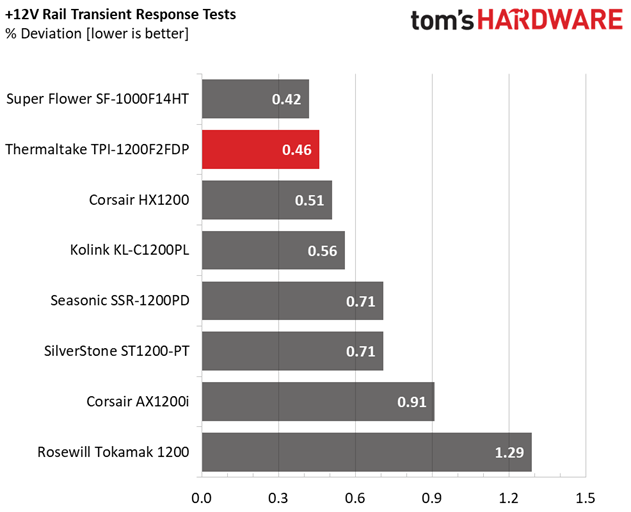



Our transient response tests are where digital platforms show their strength. Because the circuits are able to take into account many more variables and process huge chunks of data quickly, they are able to provide a fast response to dynamic loads.
Get Tom's Hardware's best news and in-depth reviews, straight to your inbox.
We should note, however, that this PSU's minor rails use an analog controller. Still, the entire primary side, which plays a critical role in determining transient performance, is fully digital.
Here are the oscilloscope screenshots we took during Advanced Transient Response Testing:
Transient Response At 20 Percent Load – 200ms




Transient Response At 20 Percent Load – 20ms




Transient Response At 20 Percent Load – 1ms




Transient Response At 50 Percent Load – 200ms
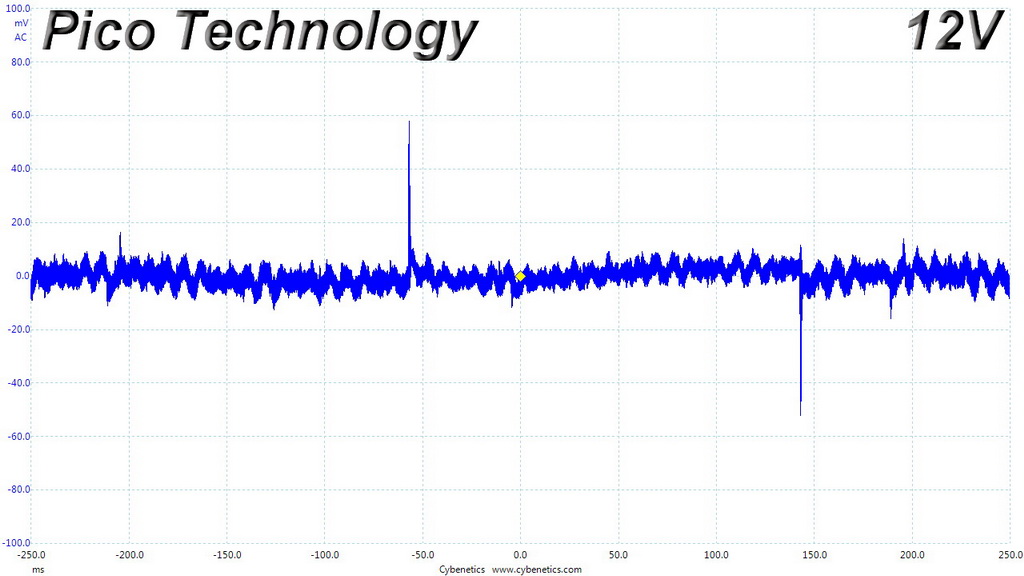



Transient Response At 50 Percent Load – 20ms



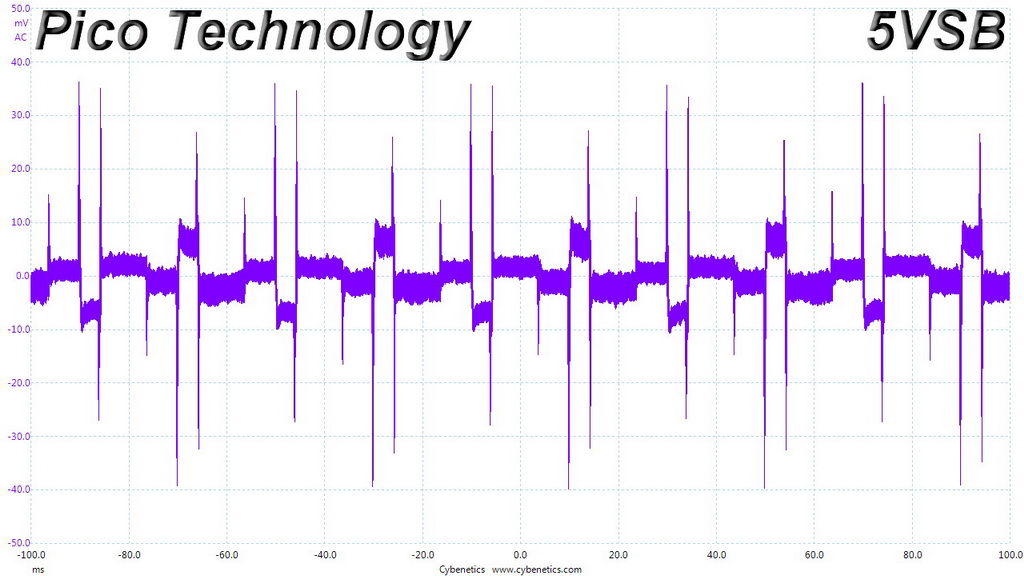
Transient Response At 50 Percent Load – 1ms
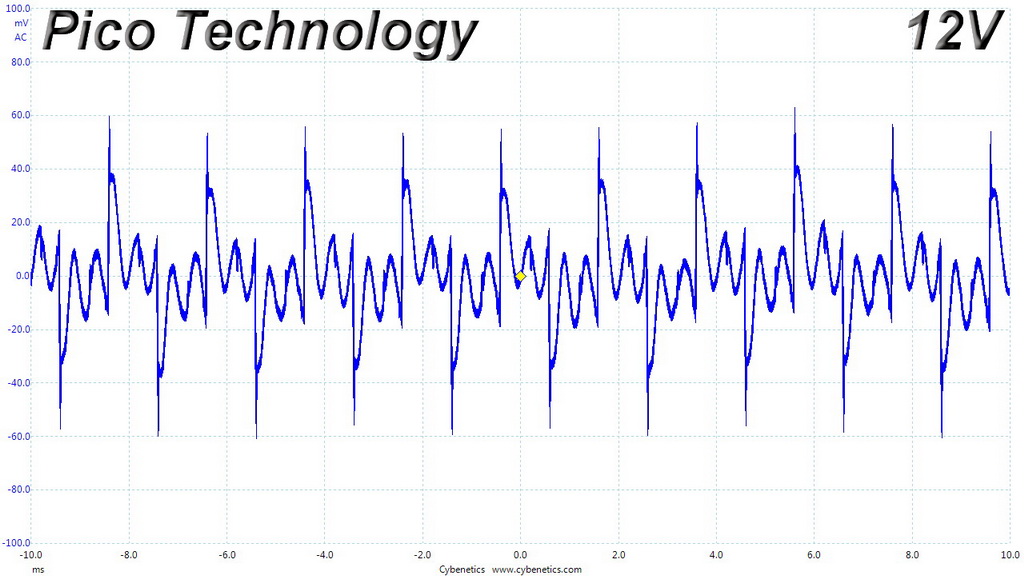



Turn-On Transient Tests
In the next set of tests, we measured the TPI-1200F2FDP's response in simpler transient load scenarios—during its power-on phase.
For our first measurement, we turned the TPI-1200F2FDP off, dialed in the maximum current the 5VSB rail could output, and switched the PSU back on. In the second test, we dialed the maximum load the +12V rail could handle and started the 1200W supply while it was in standby mode. In the last test, while the PSU was completely switched off (we cut off the power or switched the PSU off), we dialed the maximum load the +12V rail could handle before switching it back on from the loader and restoring power. The ATX specification states that recorded spikes on all rails should not exceed 10 percent of their nominal values (+10 percent for 12V is 13.2V, and 5.5 V for 5V).
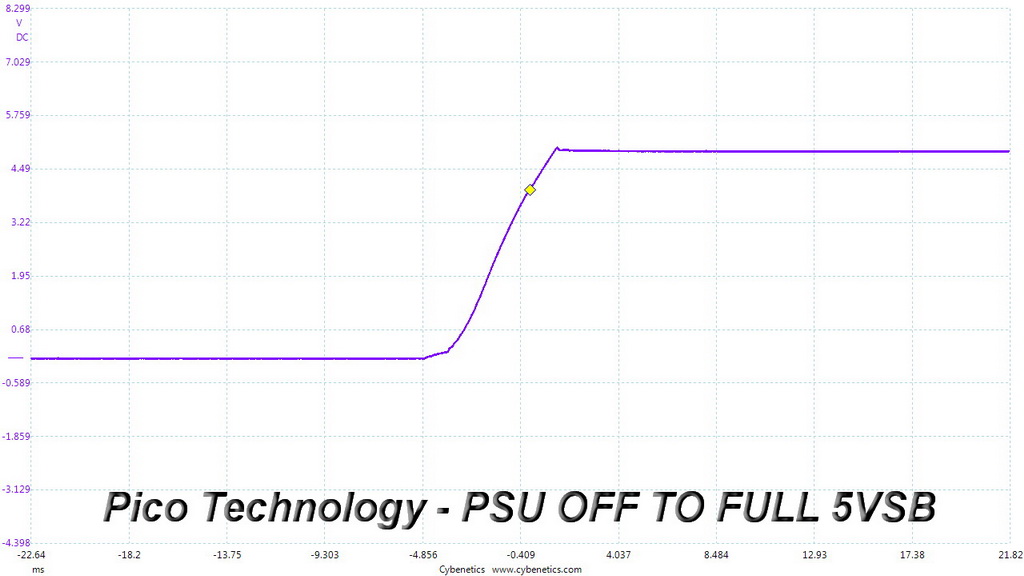


We record perfect results here!
MORE: Best Power Supplies
MORE: How We Test Power Supplies
MORE: All Power Supply Content
Current page: Transient Response Tests
Prev Page Cross-Load Tests & Infrared Images Next Page Ripple Measurements
Aris Mpitziopoulos is a contributing editor at Tom's Hardware, covering PSUs.
-
pjmelect Your videos don't work I get the error "cannot load m3u8 crossdomain access denied (2048)"Reply -
Co BIY Everyone reviews heavily on capacitor quality but how is cap quality determined ? Is it published specs or just reputation / country of origin ?Reply
The bad cap crisis was over ten years ago are all those makers
still putting out bad or inconsistent products ? -
Aris_Mp The videos work fine for me.Reply
Caps: Mostly based on experience and the RMA data that I have access to. The quality of the electrolyte is what matters the most. -
Mike Adams CapXon & Su'scon caps? more chinese junk for a premium price. I would never buy anything from ThermalsewerReply